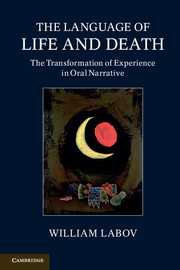Book contents
- Frontmatter
- Contents
- Preface
- Acknowledgments
- 1 Introduction to the language of life and death
- 2 Narrative analysis
- 3 The escalation of violence
- 4 Confrontations with death
- 5 Premonitions and communication with the dead
- 6 Margie Knott: “Her confrontation with the neighbors”
- 7 Gloria Stein: “They stoned the house”
- 8 Rose Norman: “The death of her younger sister”
- 9 Mary Costa: “The death of her youngest daughter”
- 10 Cache County
- 11 The vernacular origin of epic style
- 12 Historians' use of narrative
- 13 Thomas Babington Macaulay: “The death of Monmouth”
- 14 S. T. Bindoff: “The death of Elizabeth”
- 15 2 Samuel: “The death of Absalom”
- 16 The narrative view of death and life
- References
- Index
12 - Historians' use of narrative
Published online by Cambridge University Press: 05 June 2013
- Frontmatter
- Contents
- Preface
- Acknowledgments
- 1 Introduction to the language of life and death
- 2 Narrative analysis
- 3 The escalation of violence
- 4 Confrontations with death
- 5 Premonitions and communication with the dead
- 6 Margie Knott: “Her confrontation with the neighbors”
- 7 Gloria Stein: “They stoned the house”
- 8 Rose Norman: “The death of her younger sister”
- 9 Mary Costa: “The death of her youngest daughter”
- 10 Cache County
- 11 The vernacular origin of epic style
- 12 Historians' use of narrative
- 13 Thomas Babington Macaulay: “The death of Monmouth”
- 14 S. T. Bindoff: “The death of Elizabeth”
- 15 2 Samuel: “The death of Absalom”
- 16 The narrative view of death and life
- References
- Index
Summary
In 1980, Jean Robertson was collecting the oral memoirs of retired people for a dissertation in American civilization which was very much involved in the analysis of narrative. One of her subjects was an historian named Kay. In the course of her recollections, Kay told Robertson the following story.
Kay: “The Melville background”
Orientation
Mary Queen of Scots, who was very Roman Catholic, and very lovely, did employ once – I think it was Sir James Melville.
It's all in the history books.
And uh, y' know how she was always trying to eh – gain some friendship from her cousin, Queen Elizabeth in England.
And eh – so, the Melvilles have always been fairly diplomatic in their talk.
And she had sent him down to – uh – Queen Elizabeth with a message that she herself was going to have a baby.
And y' see all o' this would affect – because Elizabeth staying single as she did – ah – had no idea who would take the throne after her.
And Mary knew that Elizabeth would hate her still more,
but would hear that she had a baby.
So she thought she'd better send him.
So uh – anyway, he came to England.
And the write-up that he left is rather amusing.
Queen Elizabeth – of course you know she was sharp-feature and pale red-haired,
whereas Mary Queen o' Scots was very beautiful, with creamy skin and gorgeous rich red hair, and voluptuous compared with Elizabeth
- Type
- Chapter
- Information
- The Language of Life and DeathThe Transformation of Experience in Oral Narrative, pp. 186 - 192Publisher: Cambridge University PressPrint publication year: 2013



